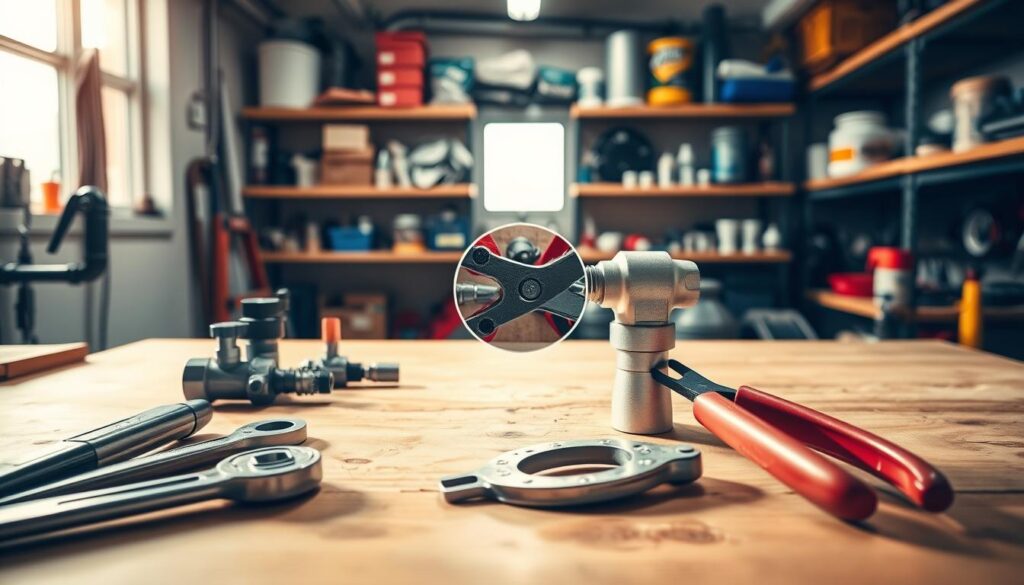A leaky faucet or a clogged drain can be a real nuisance. Fixing these issues yourself not only saves you money but also gives you a sense of accomplishment. With basic plumbing skills, you can tackle common problems at home.
Learning to fix leaky faucets, unclog drains, and handle other plumbing DIY projects can be straightforward with the right guidance. This guide provides step-by-step instructions to help you get started with DIY plumbing repair tips.
Key Takeaways
- Learn basic plumbing skills to fix common issues at home.
- Understand how to tackle leaky faucets and clogged drains.
- Follow step-by-step instructions for DIY plumbing repairs.
- Save money by doing plumbing repairs yourself.
- Gain confidence in handling plumbing DIY projects.
Understanding Basic Plumbing Tools
The foundation of successful DIY plumbing solutions lies in having the right tools at your disposal. Whether you’re tackling a leaky faucet or unclogging a drain, being equipped with the essential tools can make all the difference.
Essential Tools for DIY Plumbing
To effectively undertake plumbing DIY projects, you’ll need a variety of tools. Some of the most critical include:
- A plunger for unclogging drains
- Pipe wrenches for gripping and twisting pipes
- A pipe cutter for cutting through pipes
- Adjustable pliers for gripping small objects
- Teflon tape for creating watertight seals
- A plumber’s snake for clearing clogs deep within pipes
For more complex tasks, you may also need specialized tools. For a comprehensive list of top plumbing tools, you can refer to resources like top plumbing tools and pipes for DIY.
| Tool | Use |
|---|---|
| Plunger | Unclogging drains |
| Pipe Wrenches | Gripping and twisting pipes |
| Pipe Cutter | Cutting through pipes |
Safety Equipment and Gear
Safety should always be a top priority when undertaking DIY plumbing solutions. Essential safety equipment includes:
- Safety glasses to protect your eyes from debris
- Work gloves to protect your hands from cuts and abrasions
- A respirator mask to prevent inhalation of dust and fumes
For detailed guidance on DIY plumbing repairs and knowing when to call a professional, visit DIY plumbing fixes: a guide to simple.
Maintaining Tools for Longevity
To ensure your tools last, regular maintenance is crucial. This includes cleaning tools after use, storing them in a dry place, and regularly checking for wear and tear.
By understanding and utilizing the right tools and safety equipment, you’ll be well-equipped to handle various household plumbing repairs. This not only saves you money but also gives you the confidence to tackle plumbing issues as they arise.
Identifying Common Plumbing Issues
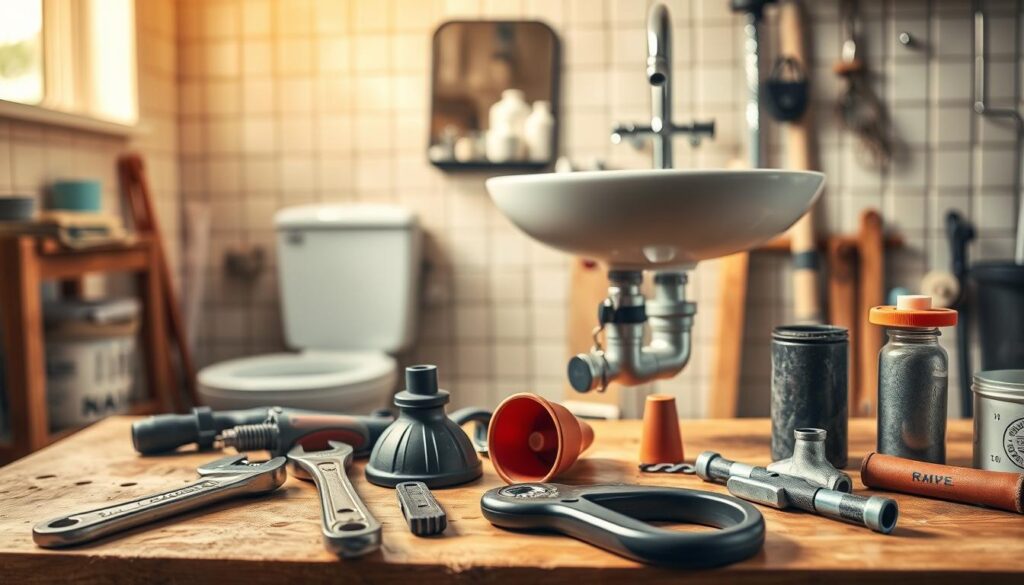
Common plumbing issues such as leaky faucets and clogged drains are more manageable when you know what to look for. Being aware of the signs can help you address problems early, potentially saving you from more extensive repairs.
Signs of a Leaky Faucet
A leaky faucet is not just annoying; it’s also a waste of water and can lead to increased utility bills. Signs include dripping water, a hissing sound, or water pooling around the faucet. To diagnose, check the faucet’s aerator and valves for mineral buildup or worn-out parts. For easy plumbing fixes for beginners, start by tightening any loose parts or replacing worn-out washers.
Recognizing Clogged Drains
Clogged drains are another common issue that can cause significant inconvenience. Signs of a clogged drain include slow draining water, gurgling sounds, or water backing up. To identify the cause, check for hair, soap scum, or grease buildup. Using a drain snake or plunger can often resolve the issue. For more stubborn clogs, consider using a chemical drain cleaner or calling a professional.
| Signs | Causes | Solutions |
|---|---|---|
| Dripping water, hissing sound | Worn-out washers, mineral buildup | Tighten loose parts, replace washers |
| Slow draining, gurgling sounds | Hair, soap scum, grease buildup | Use drain snake or plunger, chemical cleaners |
| Water backing up | Clogged drain or sewer line | Use plunger, call a professional |
Understanding Your Water Pressure
Water pressure that is too high or too low can cause issues in your plumbing system. High water pressure can lead to leaks and damage to appliances, while low pressure can result in poor water flow. Check your water pressure using a pressure gauge. If it’s too high, consider installing a pressure-reducing valve. For basic plumbing repairs at home, understanding your water pressure is crucial.
By being aware of these common plumbing issues and knowing how to identify them, you can take the first steps towards DIY plumbing repair tips and potentially avoid costly professional repairs.
Fixing a Leaky Faucet
With a few basic tools and some patience, you can easily fix a leaky faucet and prevent further water damage. A leaky faucet not only wastes water but can also lead to increased water bills and potential damage to your sink and surrounding areas.
Gathering Required Materials
Before you start, make sure you have the necessary materials. These typically include:
- Adjustable wrench or basin wrench
- Channel-type pliers (for removing old O-rings or gaskets)
- Needle-nose pliers (for reaching into tight spaces)
- Teflon tape (for creating a watertight seal)
- Replacement parts (O-rings, gaskets, or cartridges specific to your faucet type)
For a comprehensive guide on the tools needed, you can refer to our section on fixing a leaky faucet on Home Depot’s website.
Step-by-Step Leak Repair Instructions
Fixing a leaky faucet involves several steps:
- Turn off the water supply: Locate the shut-off valves under the sink and turn them clockwise.
- Disassemble the faucet: Use your adjustable wrench to remove the handle and access the internal parts.
- Identify and replace worn-out parts: Common culprits include O-rings, gaskets, or cartridges. Use Teflon tape on threaded parts to ensure a watertight seal.
- Reassemble the faucet: Put everything back together in the reverse order that you took it apart.
“The key to a successful faucet repair is patience and attention to detail. Ensuring that all parts are properly secured and sealed will prevent future leaks.”
Testing Your Repair
Once you’ve reassembled the faucet, turn on the water supply and check for leaks. Run both hot and cold water through the faucet to ensure that the repair holds under different conditions.
| Step | Description | Tips |
|---|---|---|
| 1 | Turn off water supply | Ensure valves are fully closed |
| 2 | Disassemble faucet | Use appropriate tools for your faucet type |
| 3 | Replace worn-out parts | Use Teflon tape for threaded connections |
By following these steps, you can effectively fix a leaky faucet and enjoy the satisfaction of a job well done, along with the savings on your water bill.
Unclogging Drains Safely
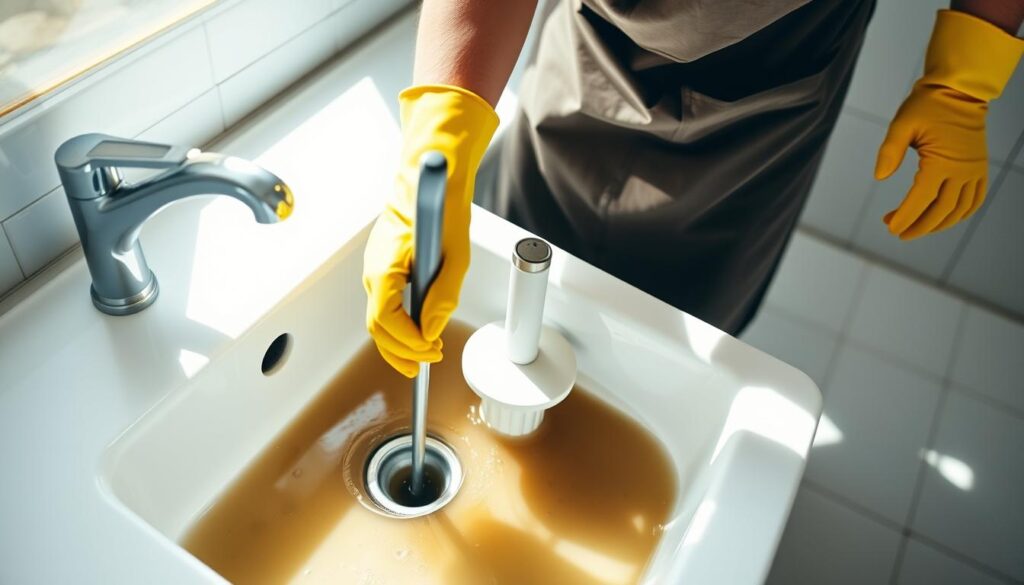
For those looking to tackle DIY plumbing repair tips, unclogging drains is a great place to start. Clogged drains are a common issue in many households, causing inconvenience and potentially leading to more serious plumbing problems if not addressed promptly.
Understanding Drain Clogs
Drain clogs occur due to the accumulation of debris, hair, soap scum, and other substances that flow through the drains. Understanding the cause of a clog is crucial to effectively clearing it. Common signs of a clogged drain include slow draining water, unusual noises, and unpleasant odors emanating from the drain.
Tools and Techniques for Unclogging
Several tools and techniques can be employed to unclog drains safely. The most common tools include plungers, drain snakes (also known as augers), and chemical drain cleaners. For a more environmentally friendly approach, a mixture of baking soda and vinegar can be used to dissolve blockages. When using a plunger, ensure the drain is covered to create suction. A drain snake can be inserted into the drain to break up or retrieve the clog. For those preferring a non-chemical method, pouring baking soda followed by vinegar down the drain can help clear the clog.
For more stubborn clogs or if you’re unsure about how to proceed, it may be wise to consult professional services. You can find emergency plumbing services at https://worldcivilsociety.com/emergency-contractor-services/ that can provide the necessary assistance.
Preventative Measures After Repairs
After successfully unclogging a drain, taking preventative measures can help avoid future clogs. Using drain screens to catch hair and other debris before they go down the drain is a simple and effective measure. Regularly cleaning your drains with baking soda and vinegar can also help maintain clear drains. Additionally, being mindful of what you dispose of through your drains, such as avoiding pouring grease or large amounts of food scraps down the kitchen sink, can significantly reduce the risk of clogs.
By understanding the causes of drain clogs, using the right tools and techniques, and implementing preventative measures, homeowners can effectively manage household plumbing repairs and keep their plumbing system in good working order. Engaging in do-it-yourself plumbing projects for beginners like unclogging drains not only saves money but also provides a sense of accomplishment and enhances one’s ability to tackle other plumbing tasks.
Repairing Running Toilets
If your toilet keeps running, it’s not just a minor issue; it can lead to significant water waste. A running toilet can be a source of frustration and increased utility bills. Fortunately, diagnosing and fixing the problem is often a straightforward DIY task.
Diagnosing the Problem
The first step in repairing a running toilet is to identify the cause. Common culprits include issues with the flapper, float, and fill valve. To diagnose the problem, start by checking the flapper for any signs of wear or misalignment. Ensure it seals properly over the flush valve. Next, inspect the float to see if it’s set too high, causing water to continuously flow into the overflow tube.
As plumbing expert John Smith once said, “Understanding the mechanics of your toilet is key to fixing common issues like a running toilet.” This emphasizes the importance of familiarizing yourself with your toilet’s components.
Step-by-Step Repair Process
Once you’ve diagnosed the issue, you can begin the repair process. For problems with the flapper, you may need to clean or replace it. Adjusting the float arm or replacing the float can resolve issues related to the water level. For fill valve problems, cleaning or replacing the valve may be necessary.
- Turn off the water supply to the toilet.
- Drain the tank.
- Inspect and clean or replace the faulty component.
- Adjust the float arm as necessary.
- Test the toilet to ensure the issue is resolved.
Tips for Ensuring Efficiency
After repairing your toilet, there are several steps you can take to ensure it operates efficiently. Regularly check the flapper and float for signs of wear. Consider upgrading to a more efficient toilet model if your current one is old or frequently problematic.
“A well-maintained toilet not only saves water but also reduces your utility bills.” This is a crucial point to remember when dealing with toilet repairs.
Replacing Toilet Seats
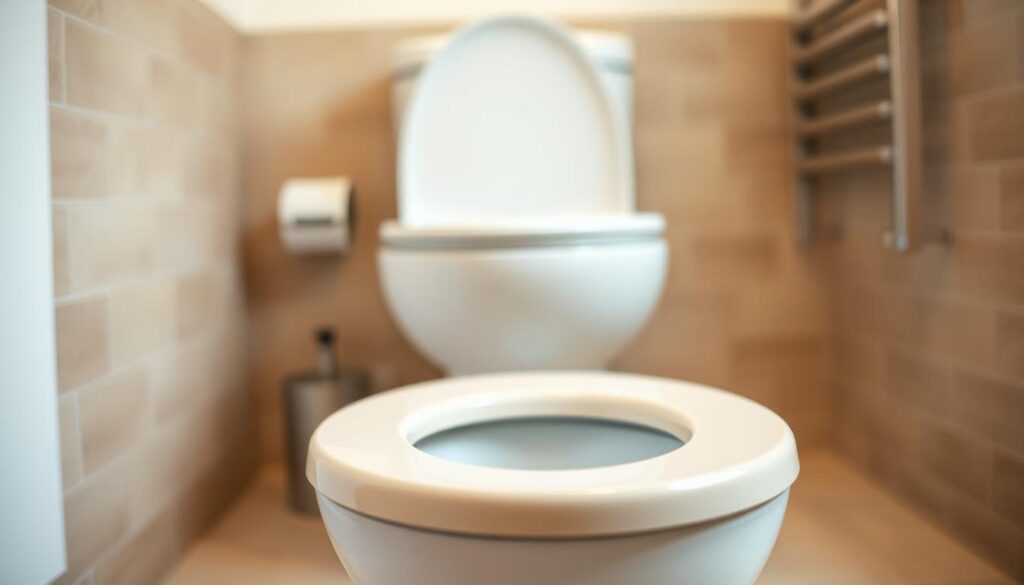
A worn-out toilet seat can be a nuisance; replacing it is easier than you think with the right guidance. Replacing a toilet seat is a simple DIY plumbing solution that can enhance the comfort and hygiene of your bathroom.
Choosing the Right Seat
Before you start, it’s crucial to select the correct toilet seat for your needs. Toilet seats come in various shapes, sizes, and materials. The most common types are round and elongated. To determine which type you need, measure the distance between the mounting bolts on your toilet.
For a more detailed guide on choosing the right toilet seat, consider the following factors:
- Shape: Round or elongated
- Material: Plastic, wood, or padded
- Color and design: To match your bathroom decor
For more information on installing a toilet seat, you can visit Home Depot’s guide.
Removal and Installation Instructions
Removing the old toilet seat is a straightforward process. First, locate the bolts at the back of the seat that secure it to the toilet bowl. Use a screwdriver to loosen and remove these bolts. Gently lift the old seat off the toilet.
To install the new seat, follow these steps:
- Place the new seat onto the toilet bowl, ensuring it is aligned with the mounting holes.
- Insert the bolts through the holes and tighten them securely with a screwdriver.
- Check that the seat is level and firmly attached.
Final Adjustments for Comfort
Once the new seat is installed, make any necessary adjustments for comfort. Some toilet seats come with additional features like slow-close hinges, which can enhance user experience.
To ensure your new toilet seat lasts, regular cleaning and maintenance are recommended. A well-maintained toilet seat can be a long-lasting part of your household plumbing repairs.
| Toilet Seat Type | Description | Best For |
|---|---|---|
| Round | Compact, traditional design | Small bathrooms, children’s toilets |
| Elongated | Longer, more comfortable design | Adult use, larger bathrooms |
“A simple DIY project like replacing a toilet seat can significantly improve your bathroom’s comfort and aesthetic appeal.” –
Replacing a toilet seat is a do-it-yourself plumbing project for beginners that can be completed with basic tools and patience. By following these steps, you can enjoy a more comfortable and hygienic bathroom experience.
Fixing a Broken Showerhead
Fixing a broken showerhead is a simple DIY task that can save you money and enhance your showering experience. A showerhead can become faulty due to mineral buildup, worn-out parts, or improper installation. Understanding the issue is crucial to applying the correct fix.
Identifying Showerhead Issues
The first step in fixing a broken showerhead is to identify the problem. Common issues include reduced water pressure, leaks, or the showerhead coming loose during use. Inspect the showerhead for visible signs of wear or mineral deposits. If the showerhead is clogged, cleaning it might resolve the issue.
Common problems and their causes:
- Mineral buildup: Hard water can cause mineral deposits to form inside the showerhead, reducing water flow.
- Worn-out parts: Over time, parts of the showerhead can wear out, leading to leaks or reduced performance.
- Improper installation: If the showerhead is not installed correctly, it can lead to issues like leaks or loose fitting.
Replacement Process Explained
If cleaning doesn’t solve the problem, it might be time to replace the showerhead. Here’s a step-by-step guide:
- Turn off the water supply: Ensure the water is turned off before you start.
- Remove the old showerhead: Use a wrench to loosen and remove the showerhead.
- Inspect the shower arm: Check for any debris or mineral buildup on the shower arm.
- Install the new showerhead: Apply Teflon tape to the threads of the shower arm and screw on the new showerhead.
- Tighten the showerhead: Use a wrench to tighten the showerhead securely.
Adjusting Water Pressure Post-Repair
After replacing or fixing the showerhead, it’s essential to check the water pressure. If the pressure is too low or too high, it can affect the performance of the new showerhead. You can adjust the water pressure by modifying the settings on your home’s water pressure regulator or by installing a showerhead with built-in pressure regulation.
| Water Pressure Level | Effect on Showerhead | Possible Solution |
|---|---|---|
| Low | Reduced water flow, poor shower experience | Check for clogs, adjust or replace the pressure regulator |
| High | Excessive water flow, potential for leaks | Install a pressure-reducing valve |
By following these steps and tips, you can effectively fix a broken showerhead and enjoy a better showering experience. Regular maintenance can also help prevent future issues.
Repairing Leaky Pipes
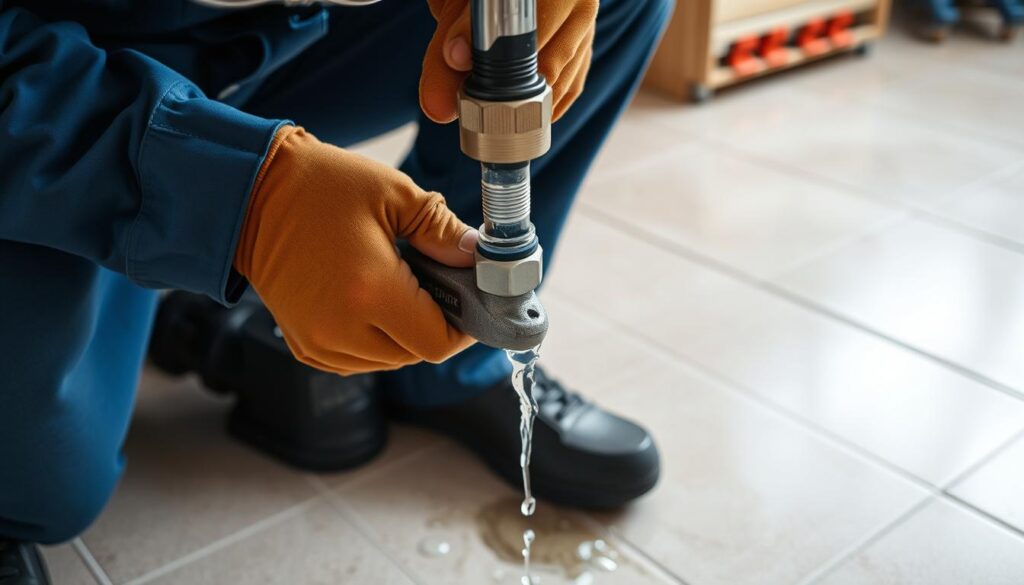
Identifying and fixing leaky pipes is essential for maintaining a safe and efficient home plumbing system. Leaky pipes can lead to water damage, mold growth, and increased water bills. Understanding the types of leaks and how to repair them is a valuable skill for homeowners.
Types of Pipe Leaks
Pipe leaks can be categorized based on their location and severity. Common types include leaks at joints, corrosion holes, and cracks due to freezing. Each type requires a different approach to repair.
- Leaks at Joints: Often due to loose connections or worn-out gaskets.
- Corrosion Holes: Result from pipe deterioration over time.
- Cracks due to Freezing: Occur when water inside pipes freezes and expands.
Step-by-Step Pipe Repair Guide
Repairing a leaky pipe involves several steps, from identifying the leak to applying the appropriate fix.
- Turn off the main water supply to prevent further leakage.
- Drain the system by opening the lowest faucet.
- Identify the type of leak and the materials needed for repair.
- Apply pipe sealant or replace the damaged section as necessary.
| Type of Leak | Repair Method | Materials Needed |
|---|---|---|
| Leaks at Joints | Tighten connections or replace gaskets | Teflon tape, new gaskets |
| Corrosion Holes | Patch or replace the corroded section | Pipe repair clamp, epoxy |
| Cracks due to Freezing | Replace the cracked section | Pipe cutter, new pipe section |
When to Call a Professional
While many leaky pipe repairs can be done DIY, certain situations require professional expertise. If the leak is significant, in a hard-to-reach location, or you’re unsure about the repair, it’s best to call a plumber.
By understanding the basics of pipe leak repair, homeowners can address issues promptly and effectively, saving time and money.
Resealing Shower Grout
Resealing shower grout is a simple yet effective way to prevent water damage and mold growth. Grout is a porous material that can absorb water, leading to potential leaks and damage over time.
Importance of Grout Maintenance
Maintaining your shower grout is crucial for the longevity of your bathroom. Regular grout maintenance prevents water from seeping behind the tiles, reducing the risk of mold and mildew. Moreover, well-maintained grout enhances the overall appearance of your bathroom, making it look cleaner and more appealing.
Neglecting grout maintenance can lead to costly repairs. Water damage can compromise the structural integrity of your bathroom, necessitating extensive and expensive renovations. By resealing your grout regularly, you can avoid these issues and ensure your bathroom remains in good condition.
Tools Needed for Resealing
To reseal your shower grout effectively, you’ll need a few essential tools. These include a grout cleaner, a grout sealant, a sealant applicator, and a clean cloth for wiping away excess sealant.
- Grout cleaner: Removes dirt and grime from the grout.
- Grout sealant: Protects the grout from water absorption.
- Sealant applicator: Helps apply the sealant evenly.
- Clean cloth: Wipes away excess sealant.
Instructions for a Successful Reseal
Begin by thoroughly cleaning the grout with a grout cleaner to remove any dirt or grime. Once the grout is clean and dry, apply the grout sealant using the sealant applicator. Ensure the sealant is applied evenly and avoid getting it on the surrounding tiles.
After applying the sealant, allow it to dry according to the manufacturer’s instructions. Use a clean cloth to wipe away any excess sealant that may have gotten on the tiles.
| Step | Description | Tips |
|---|---|---|
| 1 | Clean the grout | Use a grout cleaner and a brush to remove dirt. |
| 2 | Apply grout sealant | Use a sealant applicator for even coverage. |
| 3 | Wipe away excess | Use a clean cloth to remove excess sealant from tiles. |
By following these steps, you can effectively reseal your shower grout and protect your bathroom from water damage. Regular grout maintenance is a simple yet effective DIY plumbing solution that can save you time and money in the long run.
Installing New Fixtures
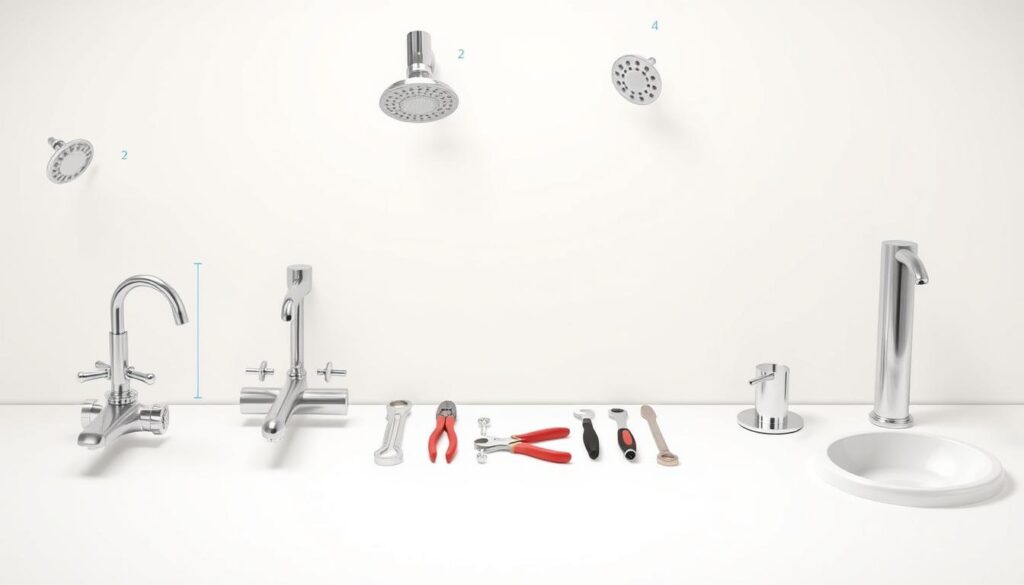
The process of installing new fixtures involves several key steps that, when followed, ensure a successful outcome. Whether you’re updating your bathroom or kitchen, new fixtures can significantly enhance the functionality and aesthetic appeal of your space.
Selecting Fixtures for Your Space
Choosing the right fixtures is crucial for a successful installation. Consider the style, material, and functionality that best suits your needs. For instance, when selecting a faucet, think about water efficiency and durability. Look for fixtures that are certified by reputable organizations, such as the EPA’s WaterSense program, to ensure they meet certain standards for water conservation.
Step-by-Step Installation Guide
Once you’ve selected your fixtures, follow the manufacturer’s installation instructions carefully. Here’s a general step-by-step guide for installing common fixtures:
- Turn off the water supply before starting the installation.
- Remove the old fixture, taking care not to damage surrounding areas.
- Inspect the area for any signs of leaks or water damage.
- Install the new fixture according to the manufacturer’s instructions.
- Test the fixture to ensure it’s working properly.
| Fixture Type | Key Considerations | Installation Tips |
|---|---|---|
| Faucets | Water efficiency, durability | Ensure proper mounting to avoid leaks. |
| Toilets | Water conservation, comfort | Check for proper flushing mechanism. |
| Showerheads | Water pressure, spray pattern | Clean the shower arm before installation. |
Ensuring Fixtures Function Properly
After installation, it’s crucial to test your new fixtures to ensure they’re functioning as expected. Check for leaks, proper water pressure, and overall performance. Regular maintenance can extend the life of your fixtures and prevent future issues.
By following these steps and guidelines, you can successfully install new fixtures in your home, enhancing both the functionality and aesthetic appeal of your living spaces.
Understanding Home Plumbing Systems
To tackle basic plumbing repairs at home, it’s essential to grasp the fundamentals of your home’s plumbing system. A comprehensive understanding of the system’s components and their functions will empower you to perform DIY plumbing repairs effectively.
Basic Components of Plumbing Systems
A typical home plumbing system consists of several key components, including pipes, fixtures, and valves. The pipes are responsible for distributing water throughout the home, while fixtures such as faucets and toilets utilize this water for various purposes. Valves, on the other hand, control the flow of water within the system.
The main components work together to provide a functional plumbing system. For more detailed information on understanding your home’s plumbing system, you can visit The Plumbing Basics: Understanding Your Home Plumbing.
Role of the Main Shut-Off Valve
The main shut-off valve is a critical component of your home’s plumbing system, as it allows you to control the water supply to the entire house. By turning this valve clockwise, you can shut off the water supply in case of emergencies or when performing DIY plumbing repair tips such as fixing leaky faucets or replacing toilet seats.
It’s essential to familiarize yourself with the location of the main shut-off valve, typically found near the water meter or where the water line enters the home. Regularly checking the valve ensures it’s functioning correctly and can be turned easily when needed.
Importance of Cleanouts
Cleanouts are another vital component of your plumbing system, providing access points for clearing clogs and performing maintenance tasks. These cleanouts allow plumbers or homeowners to insert plumbing snakes or other equipment to clear blockages in the pipes.
| Component | Function | Importance |
|---|---|---|
| Pipes | Distribute water throughout the home | Essential for delivering water to fixtures |
| Fixtures | Utilize water for various purposes | Provide functionality for daily activities |
| Valves | Control water flow within the system | Crucial for regulating water pressure and flow |
By understanding the basic components of your home’s plumbing system, including the main shut-off valve and cleanouts, you’ll be better equipped to tackle plumbing DIY projects and perform basic plumbing repairs at home.
Winterizing Your Plumbing
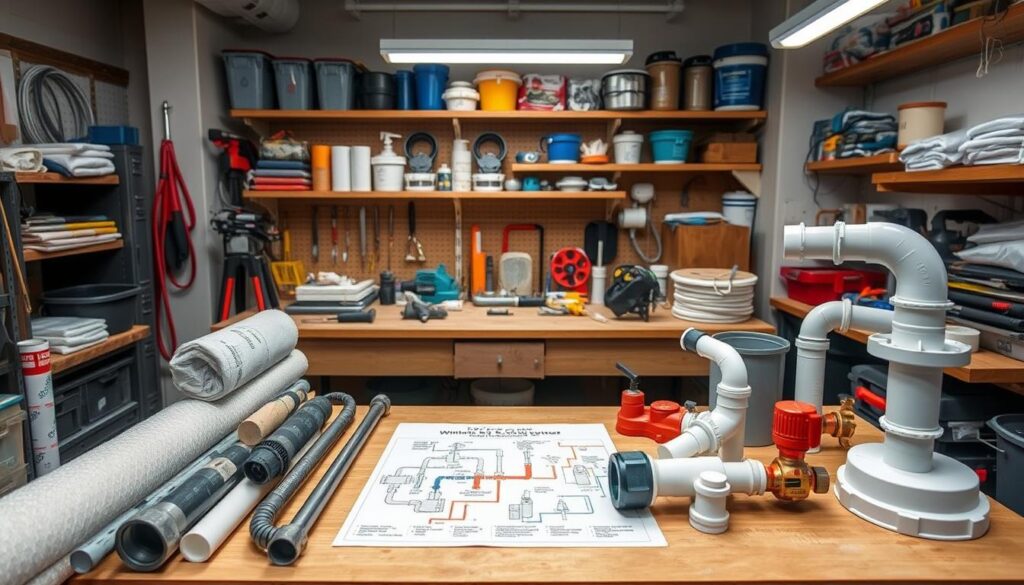
Winterizing your plumbing is a crucial task that helps prevent costly damages and disruptions during the cold months. As temperatures drop, the risk of pipes freezing and bursting increases, potentially leading to significant water damage and costly repairs.
Areas Prone to Freezing
The first step in winterizing your plumbing is to identify areas that are most susceptible to freezing. These typically include:
- Pipes in unheated areas such as the garage, basement, or crawlspace.
- Outdoor faucets and hoses.
- Pipes along exterior walls or in areas with poor insulation.
By identifying these vulnerable areas, you can take targeted actions to protect them.
Step-by-Step Winterizing Process
Once you’ve identified the areas prone to freezing, follow these steps to winterize your plumbing:
- Disconnect and Drain Hoses: Remove and store outdoor hoses to prevent water from freezing within them.
- Insulate Exposed Pipes: Use foam pipe insulation or wrap pipes with heat tape or thermostatically controlled heat cables.
- Seal Leaks and Cracks: Use caulk or spray foam to seal any gaps or cracks around windows, doors, and pipes to keep cold air out.
- Let Cold Water Drip: Allow cold water to drip from faucets served by exposed pipes to reduce the risk of freezing.
- Open Cabinet Doors: Open kitchen and bathroom cabinet doors to allow warmer air to circulate around the plumbing.
Checking for Damage Before Winter
Before winter sets in, it’s essential to inspect your plumbing system for any signs of damage or wear. Check for:
| Area to Inspect | Potential Issues | Action |
|---|---|---|
| Pipes and Fittings | Leaks, corrosion, or damage | Repair or replace damaged components |
| Water Heater | Signs of leakage or malfunction | Inspect and service the water heater |
| Outdoor Faucets | Freezing or damage | Consider installing freeze-proof faucets |
By taking these proactive steps, you can significantly reduce the risk of plumbing-related issues during the winter months, ensuring your home remains safe and comfortable.
Tips for Avoiding Future Plumbing Problems
Maintaining your home’s plumbing system is crucial to preventing future issues. By adopting regular maintenance practices, you can avoid common problems like clogs and leaks.
Regular Maintenance Practices
Regularly inspecting your pipes and faucets for signs of damage or leaks is essential. Avoid throwing non-degradable items in the sink or toilet, and refrain from pouring grease or oil down the drain, as it can solidify and clog your pipes. For more detailed DIY plumbing repair tips, you can explore resources like Hi-Spec Plumbing.
Resources for DIY Plumbing Help
For homeowners new to plumbing DIY projects, there are numerous resources available online that provide easy plumbing fixes for beginners. Utilize these resources to learn new skills and gain confidence in tackling simple plumbing tasks.
Recognizing When to Seek Professional Help
While DIY plumbing repair tips can be helpful, it’s essential to recognize when to seek professional assistance. If you’re dealing with complex issues or unsure about how to proceed, consider hiring a professional plumbing service to conduct yearly maintenance checks and repairs.
